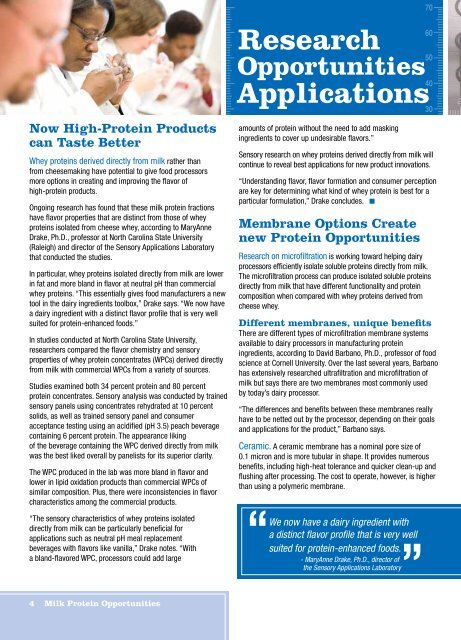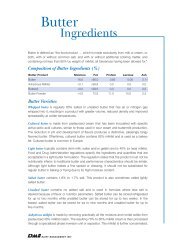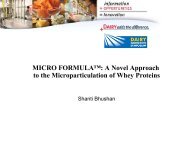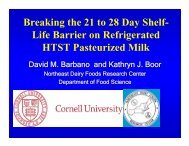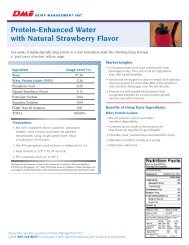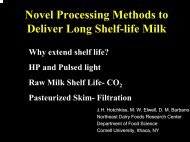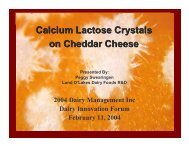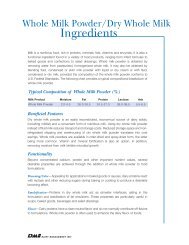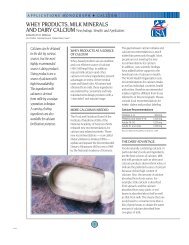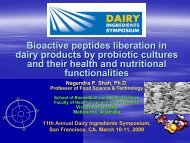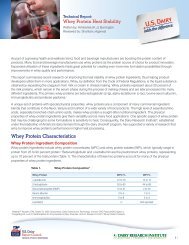Emerging Milk Protein Opportunities - InnovateWithDairy.com
Emerging Milk Protein Opportunities - InnovateWithDairy.com
Emerging Milk Protein Opportunities - InnovateWithDairy.com
Create successful ePaper yourself
Turn your PDF publications into a flip-book with our unique Google optimized e-Paper software.
70<br />
Now High-<strong>Protein</strong> Products<br />
can Taste Better<br />
Whey proteins derived directly from milk rather than<br />
from cheesemaking have potential to give food processors<br />
more options in creating and improving the flavor of<br />
high-protein products.<br />
Ongoing research has found that these milk protein fractions<br />
have flavor properties that are distinct from those of whey<br />
proteins isolated from cheese whey, according to MaryAnne<br />
Drake, Ph.D., professor at North Carolina State University<br />
(Raleigh) and director of the Sensory Applications Laboratory<br />
that conducted the studies.<br />
In particular, whey proteins isolated directly from milk are lower<br />
in fat and more bland in flavor at neutral pH than <strong>com</strong>mercial<br />
whey proteins. “This essentially gives food manufacturers a new<br />
tool in the dairy ingredients toolbox,” Drake says. “We now have<br />
a dairy ingredient with a distinct flavor profile that is very well<br />
suited for protein-enhanced foods.”<br />
In studies conducted at North Carolina State University,<br />
researchers <strong>com</strong>pared the flavor chemistry and sensory<br />
properties of whey protein concentrates (WPCs) derived directly<br />
from milk with <strong>com</strong>mercial WPCs from a variety of sources.<br />
Studies examined both 34 percent protein and 80 percent<br />
protein concentrates. Sensory analysis was conducted by trained<br />
sensory panels using concentrates rehydrated at 10 percent<br />
solids, as well as trained sensory panel and consumer<br />
acceptance testing using an acidified (pH 3.5) peach beverage<br />
containing 6 percent protein. The appearance liking<br />
of the beverage containing the WPC derived directly from milk<br />
was the best liked overall by panelists for its superior clarity.<br />
The WPC produced in the lab was more bland in flavor and<br />
lower in lipid oxidation products than <strong>com</strong>mercial WPCs of<br />
similar <strong>com</strong>position. Plus, there were inconsistencies in flavor<br />
characteristics among the <strong>com</strong>mercial products.<br />
“The sensory characteristics of whey proteins isolated<br />
directly from milk can be particularly beneficial for<br />
applications such as neutral pH meal replacement<br />
beverages with flavors like vanilla,” Drake notes. “With<br />
a bland-flavored WPC, processors could add large<br />
Research<br />
<strong>Opportunities</strong><br />
Applications<br />
amounts of protein without the need to add masking<br />
ingredients to cover up undesirable flavors.”<br />
Sensory research on whey proteins derived directly from milk will<br />
continue to reveal best applications for new product innovations.<br />
“Understanding flavor, flavor formation and consumer perception<br />
are key for determining what kind of whey protein is best for a<br />
particular formulation,” Drake concludes.<br />
Membrane Options Create<br />
new <strong>Protein</strong> <strong>Opportunities</strong><br />
Research on microfiltration is working toward helping dairy<br />
processors efficiently isolate soluble proteins directly from milk.<br />
The microfiltration process can produce isolated soluble proteins<br />
directly from milk that have different functionality and protein<br />
<strong>com</strong>position when <strong>com</strong>pared with whey proteins derived from<br />
cheese whey.<br />
Different membranes, unique benefits<br />
There are different types of microfiltration membrane systems<br />
available to dairy processors in manufacturing protein<br />
ingredients, according to David Barbano, Ph.D., professor of food<br />
science at Cornell University. Over the last several years, Barbano<br />
has extensively researched ultrafiltration and microfiltration of<br />
milk but says there are two membranes most <strong>com</strong>monly used<br />
by today’s dairy processor.<br />
“The differences and benefits between these membranes really<br />
have to be netted out by the processor, depending on their goals<br />
and applications for the product,” Barbano says.<br />
Ceramic. A ceramic membrane has a nominal pore size of<br />
0.1 micron and is more tubular in shape. It provides numerous<br />
benefits, including high-heat tolerance and quicker clean-up and<br />
flushing after processing. The cost to operate, however, is higher<br />
than using a polymeric membrane.<br />
“<br />
We now have a dairy ingredient with<br />
a distinct flavor profile that is very well<br />
suited for protein-enhanced foods.<br />
”<br />
- MaryAnne Drake, Ph.D., director of<br />
the Sensory Applications Laboratory<br />
60<br />
50<br />
40<br />
30<br />
10<br />
4 <strong>Milk</strong> <strong>Protein</strong> <strong>Opportunities</strong>


